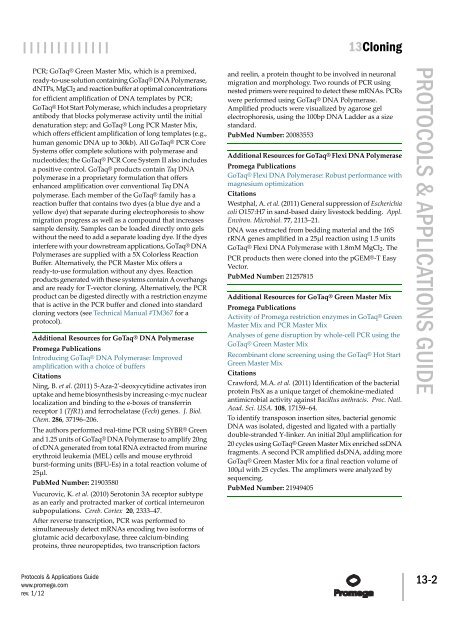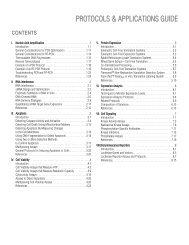Cloning Protocols and Applications Guide-A4 format - Promega
Cloning Protocols and Applications Guide-A4 format - Promega
Cloning Protocols and Applications Guide-A4 format - Promega
You also want an ePaper? Increase the reach of your titles
YUMPU automatically turns print PDFs into web optimized ePapers that Google loves.
||||||||||||| 13<strong>Cloning</strong><br />
PCR; GoTaq® Green Master Mix, which is a premixed,<br />
ready-to-use solution containing GoTaq® DNA Polymerase,<br />
dNTPs, MgCl2 <strong>and</strong> reaction buffer at optimal concentrations<br />
for efficient amplification of DNA templates by PCR;<br />
GoTaq® Hot Start Polymerase, which includes a proprietary<br />
antibody that blocks polymerase activity until the initial<br />
denaturation step; <strong>and</strong> GoTaq® Long PCR Master Mix,<br />
which offers efficient amplification of long templates (e.g.,<br />
human genomic DNA up to 30kb). All GoTaq® PCR Core<br />
Systems offer complete solutions with polymerase <strong>and</strong><br />
nucleotides; the GoTaq® PCR Core System II also includes<br />
a positive control. GoTaq® products contain Taq DNA<br />
polymerase in a proprietary formulation that offers<br />
enhanced amplification over conventional Taq DNA<br />
polymerase. Each member of the GoTaq® family has a<br />
reaction buffer that contains two dyes (a blue dye <strong>and</strong> a<br />
yellow dye) that separate during electrophoresis to show<br />
migration progress as well as a compound that increases<br />
sample density. Samples can be loaded directly onto gels<br />
without the need to add a separate loading dye. If the dyes<br />
interfere with your downstream applications, GoTaq® DNA<br />
Polymerases are supplied with a 5X Colorless Reaction<br />
Buffer. Alternatively, the PCR Master Mix offers a<br />
ready-to-use formulation without any dyes. Reaction<br />
products generated with these systems contain A overhangs<br />
<strong>and</strong> are ready for T-vector cloning. Alternatively, the PCR<br />
product can be digested directly with a restriction enzyme<br />
that is active in the PCR buffer <strong>and</strong> cloned into st<strong>and</strong>ard<br />
cloning vectors (see Technical Manual #TM367 for a<br />
protocol).<br />
Additional Resources for GoTaq® DNA Polymerase<br />
<strong>Promega</strong> Publications<br />
Introducing GoTaq® DNA Polymerase: Improved<br />
amplification with a choice of buffers<br />
Citations<br />
Ning, B. et al. (2011) 5-Aza-2'-deoxycytidine activates iron<br />
uptake <strong>and</strong> heme biosynthesis by increasing c-myc nuclear<br />
localization <strong>and</strong> binding to the e-boxes of transferrin<br />
receptor 1 (TfR1) <strong>and</strong> ferrochelatase (Fech) genes. J. Biol.<br />
Chem. 286, 37196–206.<br />
The authors performed real-time PCR using SYBR® Green<br />
<strong>and</strong> 1.25 units of GoTaq® DNA Polymerase to amplify 20ng<br />
of cDNA generated from total RNA extracted from murine<br />
erythroid leukemia (MEL) cells <strong>and</strong> mouse erythroid<br />
burst-forming units (BFU-Es) in a total reaction volume of<br />
25µl.<br />
PubMed Number: 21903580<br />
Vucurovic, K. et al. (2010) Serotonin 3A receptor subtype<br />
as an early <strong>and</strong> protracted marker of cortical interneuron<br />
subpopulations. Cereb. Cortex 20, 2333–47.<br />
After reverse transcription, PCR was performed to<br />
simultaneously detect mRNAs encoding two isoforms of<br />
glutamic acid decarboxylase, three calcium-binding<br />
proteins, three neuropeptides, two transcription factors<br />
<strong>Protocols</strong> & <strong>Applications</strong> <strong>Guide</strong><br />
www.promega.com<br />
rev. 1/12<br />
<strong>and</strong> reelin, a protein thought to be involved in neuronal<br />
migration <strong>and</strong> morphology. Two rounds of PCR using<br />
nested primers were required to detect these mRNAs. PCRs<br />
were performed using GoTaq® DNA Polymerase.<br />
Amplified products were visualized by agarose gel<br />
electrophoresis, using the 100bp DNA Ladder as a size<br />
st<strong>and</strong>ard.<br />
PubMed Number: 20083553<br />
Additional Resources for GoTaq® Flexi DNA Polymerase<br />
<strong>Promega</strong> Publications<br />
GoTaq® Flexi DNA Polymerase: Robust performance with<br />
magnesium optimization<br />
Citations<br />
Westphal, A. et al. (2011) General suppression of Escherichia<br />
coli O157:H7 in s<strong>and</strong>-based dairy livestock bedding. Appl.<br />
Environ. Microbiol. 77, 2113–21.<br />
DNA was extracted from bedding material <strong>and</strong> the 16S<br />
rRNA genes amplified in a 25µl reaction using 1.5 units<br />
GoTaq® Flexi DNA Polymerase with 1.8mM MgCl2. The<br />
PCR products then were cloned into the pGEM®-T Easy<br />
Vector.<br />
PubMed Number: 21257815<br />
Additional Resources for GoTaq® Green Master Mix<br />
<strong>Promega</strong> Publications<br />
Activity of <strong>Promega</strong> restriction enzymes in GoTaq® Green<br />
Master Mix <strong>and</strong> PCR Master Mix<br />
Analyses of gene disruption by whole-cell PCR using the<br />
GoTaq® Green Master Mix<br />
Recombinant clone screening using the GoTaq® Hot Start<br />
Green Master Mix<br />
Citations<br />
Crawford, M.A. et al. (2011) Identification of the bacterial<br />
protein FtsX as a unique target of chemokine-mediated<br />
antimicrobial activity against Bacillus anthracis. Proc. Natl.<br />
Acad. Sci. USA. 108, 17159–64.<br />
To identify transposon insertion sites, bacterial genomic<br />
DNA was isolated, digested <strong>and</strong> ligated with a partially<br />
double-str<strong>and</strong>ed Y-linker. An initial 20µl amplification for<br />
20 cycles using GoTaq® Green Master Mix enriched ssDNA<br />
fragments. A second PCR amplified dsDNA, adding more<br />
GoTaq® Green Master Mix for a final reaction volume of<br />
100µl with 25 cycles. The amplimers were analyzed by<br />
sequencing.<br />
PubMed Number: 21949405<br />
PROTOCOLS & APPLICATIONS GUIDE 13-2

















